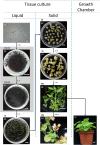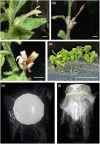Genome Editing and Protoplast Regeneration to Study Plant-Pathogen Interactions in the Model Plant Nicotiana benthamiana
- PMID: 34713245
- PMCID: PMC8525392
- DOI: 10.3389/fgeed.2020.627803
Genome Editing and Protoplast Regeneration to Study Plant-Pathogen Interactions in the Model Plant Nicotiana benthamiana
Abstract
Biotic diseases cause substantial agricultural losses annually, spurring research into plant pathogens and strategies to mitigate them. Nicotiana benthamiana is a commonly used model plant for studying plant-pathogen interactions because it is host to numerous plant pathogens and because many research tools are available for this species. The clustered regularly interspaced short palindromic repeats (CRISPR) system is one of several powerful tools available for targeted gene editing, a crucial strategy for analyzing gene function. Here, we demonstrate the use of various CRISPR-associated (Cas) proteins for gene editing of N. benthamiana protoplasts, including Staphylococcus aureus Cas9 (SaCas9), Streptococcus pyogenes Cas9 (SpCas9), Francisella novicida Cas12a (FnCas12a), and nCas9-activation-induced cytidine deaminase (nCas9-Target-AID). We successfully mutated Phytoene Desaturase (PDS) and Ethylene Receptor 1 (ETR1) and the disease-associated genes RNA-Dependent RNA Polymerase 6 (RDR6), and Suppressor of Gene Silencing 3 (SGS3), and confirmed that the mutated alleles were transmitted to progeny. sgs3 mutants showed the expected phenotype, including absence of trans-acting siRNA3 (TAS3) siRNA and abundant expression of the GFP reporter. Progeny of both sgs3 and rdr6 null mutants were sterile. Our analysis of the phenotypes of the regenerated progeny indicated that except for the predicted phenotypes, they grew normally, with no unexpected traits. These results confirmed the utility of gene editing followed by protoplast regeneration in N. benthamiana. We also developed a method for in vitro flowering and seed production in N. benthamiana, allowing the regenerants to produce progeny in vitro without environmental constraints.
Keywords: FnCas12a; RDR6; SGS3; SaCas9; SpCas9; nCas9-Target-AID.
Copyright © 2021 Hsu, Lee, Cheng, Yuan, Wu and Lin.
Conflict of interest statement
The authors declare that the research was conducted in the absence of any commercial or financial relationships that could be construed as a potential conflict of interest.
Figures





References
-
- Chiu Y. T., Lin C. S., Chang C. (2011). In vitro fruiting and seed production in Erycina pusilla (L.) NH Williams and MW Chase. Propag. Ornam. Plants 11, 131–136.
LinkOut - more resources
Full Text Sources
Miscellaneous

